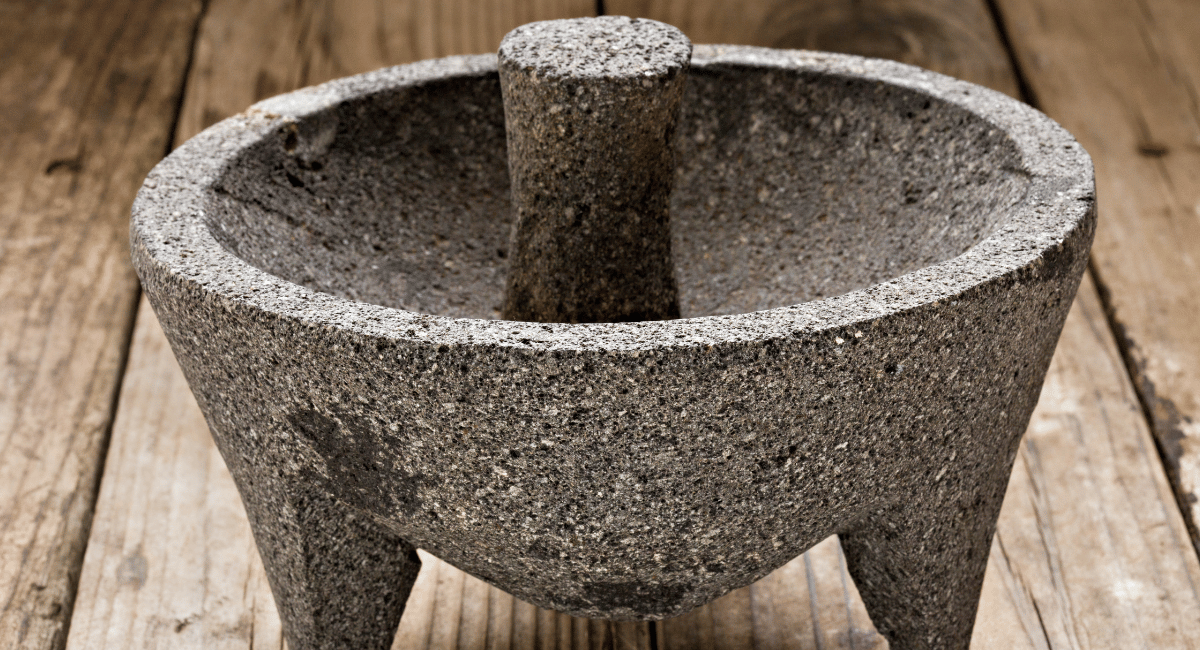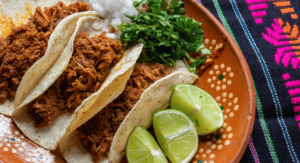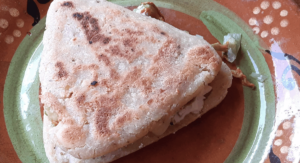The molcajete, a revered symbol of Mexican culinary tradition, embodies the artistry of grinding spices, crafting salsas, and preparing flavorful pastes integral to the vibrant tapestry of Mexican dishes.
This section aims to expain the role of the molcajete in traditional Mexican cooking and its significance in enhancing flavors through time-honored techniques.
Table of Contents
What is the Molcajete?
The molcajete is an indispensable piece of traditional Mexican cooking equipment that has been used for centuries. It’s a type of mortar and pestle crafted from volcanic rock, typically made from basalt. This culinary tool holds deep cultural significance and plays a vital role in Mexican cuisine, revered for its ability to grind, crush, and blend various ingredients.
Crafted from a single piece of volcanic stone, the molcajete showcases a rough, porous surface ideal for grinding spices, herbs, and other ingredients. Its surface texture aids in breaking down and blending flavors, allowing cooks to create vibrant salsas, moles, guacamole, and spice mixes that characterize the rich and diverse Mexican culinary landscape.

Traditional Use
Using a molcajete to grind spices like cumin, cloves, and peppercorns is a meticulous yet rewarding process that enhances the flavors in Mexican cuisine. The volcanic rock surface of the molcajete is rough and porous, ideal for grinding spices.
Firstly, the selected whole spices are added to the molcajete, and then using a tejolote (the pestle), they are ground with a pressing and grinding motion. This action breaks down the spices, releasing their essential oils and intensifying their aroma and taste.
Benefits
The benefits of using a molcajete for grinding spices are numerous: it allows for greater control over the texture of the spices, offering a range from coarse to fine. This impacts the final dish’s consistency and flavor distribution. The gradual grinding process ensures that the essential oils are preserved, contributing to a more potent and flavorful spice mix. Additionally, the volcanic rock material of the molcajete imparts a unique depth and earthiness to the spices, enhancing their overall profile in Mexican dishes.
The use of a molcajete in grinding spices aligns with the authenticity of traditional Mexican cooking methods. It thus connects modern cooks with centuries-old culinary practices, allowing users to replicate flavors and textures that are true to the roots of Mexican gastronomy. This authenticity is highly prized among enthusiasts seeking genuine and traditional flavors in their homemade dishes.
In summary, employing a molcajete for grinding spices provides a hands-on, sensory experience that enhances the flavors of Mexican cuisine. The process not only yields finely ground spices but also preserves their essential oils and authenticity, creating a distinctive taste profile in dishes that cannot be replicated with conventional grinding methods.
Crafting Salsas
Using a molcajete to prepare salsa, particularly with ingredients like tomatoes, onions, and chilies, is an artful process that profoundly impacts the flavors and textures of Mexican dishes.

Process
The rough surface of the molcajete plays a pivotal role in enhancing salsa flavors. As the ingredients are added to the molcajete, the volcanic rock surface efficiently breaks them down through grinding and crushing motions with the tejolote.
This action not only combines the flavors but also allows the rough texture to extract juices and essential oils from the ingredients like tomatoes, onions, and chilies. Consequently, the resulting salsa boasts robust, well-mingled flavors and a rustic texture that lends an authentic and earthy essence to the dish. The friction between the ingredients and the molcajete’s surface ensures that every component is thoroughly integrated, creating a harmonious blend of flavors that enriches the overall taste of Mexican cuisine.
Personalization
Moreover, the molcajete empowers cooks to dictate the texture and consistency of their salsa according to their preferences. By controlling the grinding intensity and duration, chefs can achieve varying degrees of coarseness or smoothness in the salsa. As a result, personalized touch can be felt in each preparation, with the texture complementing the dish served.
Whether it’s a chunky, textured salsa for tacos or a smoother version for topping grilled meats, the molcajete facilitates this customization, contributing to the distinctiveness of each salsa and elevating the dining experience.
Preparing Pastes
The use of a molcajete in preparing pastes involving ingredients like garlic, herbs, and spices plays a pivotal role in merging flavors, creating concentrated mixtures crucial for marinades, adobos, or robust rubs for meats in Mexican cuisine.
The rough volcanic surface of the molcajete, combined with the grinding action of the tejolote, facilitates the amalgamation of various ingredients into cohesive pastes. This process allows the flavors of garlic, fresh herbs, and spices to meld together, intensifying their essence and creating concentrated flavor profiles. These pastes are fundamental in Mexican culinary traditions, forming the base for marinades that infuse meats with depth, adobos that tenderize and flavor, or robust rubs that enhance the taste of grilled meats.
Recipes
Commonly, the molcajete is utilized in recipes such as traditional adobo sauces for meats, where a blend of chilies, garlic, spices, and herbs is meticulously ground to form a thick, flavorful paste. It’s also integral in crafting marinades for various meats, where combinations of ingredients, like achiote paste (made from annatto seeds, spices, and herbs), are ground together to create a concentrated marinade for pork or chicken.
Additionally, the molcajete finds its place in creating flavorful rubs for meats like carne asada or al pastor, where spices, herbs, and aromatics are merged into a paste and rubbed onto the meat before cooking, imparting intense flavors.
Authentic recipes that pair perfectly with the molcajete include salsa molcajeteada, a rustic salsa made by grinding roasted tomatoes, chilies, garlic, and onions in the molcajete. Another traditional dish is guacamole, where ripe avocados, cilantro, chilies, and lime juice are expertly combined in the molcajete to create a creamy yet textured dip. Additionally, the molcajete is essential in preparing various moles, like mole poblano, where a blend of spices, chilies, nuts, and chocolate is ground into a rich, complex sauce.

Ensuring Optimal Use
Seasoning the Molcajete
Seasoning a new molcajete is crucial to ensure its optimal performance and prevent unwanted debris from affecting the flavors of ground spices or pastes.
- Cleaning the Molcajete: Start by thoroughly cleaning the molcajete with warm water and a stiff brush to remove any loose grit or dust from the manufacturing process.
- Grinding Rice or Corn: Once cleaned, grind a handful of uncooked rice or corn in the molcajete using the tejolote. This process helps to further remove any remaining debris, smooth out rough spots, and season the surface. Discard the ground rice or corn.
- Repeat the Process: This grinding process might need to be repeated a few times until the debris decreases, and the surface becomes smoother. Some cooks also suggest adding a few drops of water during grinding to form a paste-like consistency, aiding in the seasoning process.
- Air-Drying: After seasoning, thoroughly rinse the molcajete with water and allow it to air-dry completely before use. This seasoning method helps remove unwanted particles and enhances the molcajete’s grinding efficiency, ensuring that flavors remain pure and unaffected.
Cleaning and Maintenance
Maintaining a molcajete is essential to preserve its porous volcanic surface and ensure its longevity.
- Gentle Cleaning: Avoid using harsh detergents or abrasive cleaners that could damage the porous surface of the molcajete. Instead, use warm water and a soft brush or cloth to clean it after each use.
- Removing Residue: Stubborn residue or stuck-on food can be removed by grinding a mixture of coarse salt and water in the molcajete. The abrasive nature of salt helps to dislodge particles without damaging the surface.
- Air-Drying: After washing, always allow the molcajete to air-dry thoroughly. Avoid storing it in closed or damp spaces to prevent mold or mildew growth.
- Occasional Re-Seasoning: Over time, the seasoning might wear off due to use. Re-season the molcajete periodically by grinding rice or corn as described in the seasoning process to maintain its efficiency.
By following these steps for seasoning, cleaning, and maintenance, one can ensure that the molcajete remains in optimal condition, free from unwanted particles, and ready to impart authentic flavors to Mexican dishes.
Frequently Asked Questions
Can I grind wet ingredients in a molcajete?
Yes, you can grind wet ingredients like garlic or tomatoes. Ensure thorough cleaning and drying afterward to prevent odors.
How do I prevent flavors from transferring between uses?
Grind white rice in the molcajete to absorb any leftover flavors before using it for different ingredients.
Can I use a molcajete for spices other than Mexican?
Absolutely. The molcajete is versatile and can be used for various spices and herb grinding, enhancing flavors in diverse cuisines.
Conclusion
The molcajete with its traditional use in grinding spices, crafting salsas, and preparing flavorful pastes serves as a testament to the dedication of honoring authentic flavors and techniques.
Incorporating a molcajete into the kitchen not only enriches the culinary experience but also fosters a deep appreciation for the time-honored traditions and cultural heritage encapsulated in Mexican gastronomy.
Embracing the molcajete empowers home cooks to infuse their dishes with the genuine essence and flavors of Mexico, celebrating the depth of traditional Mexican cooking.
For further reading on Mexican cooking equipment, visit this A to Z of Mexican Cooking Equipment.





